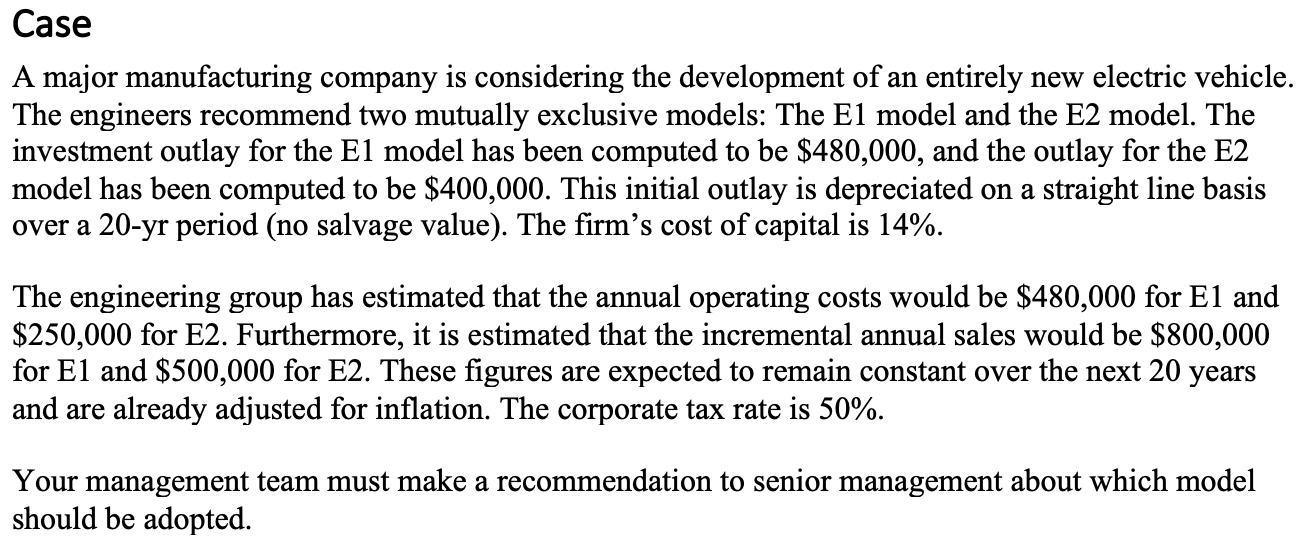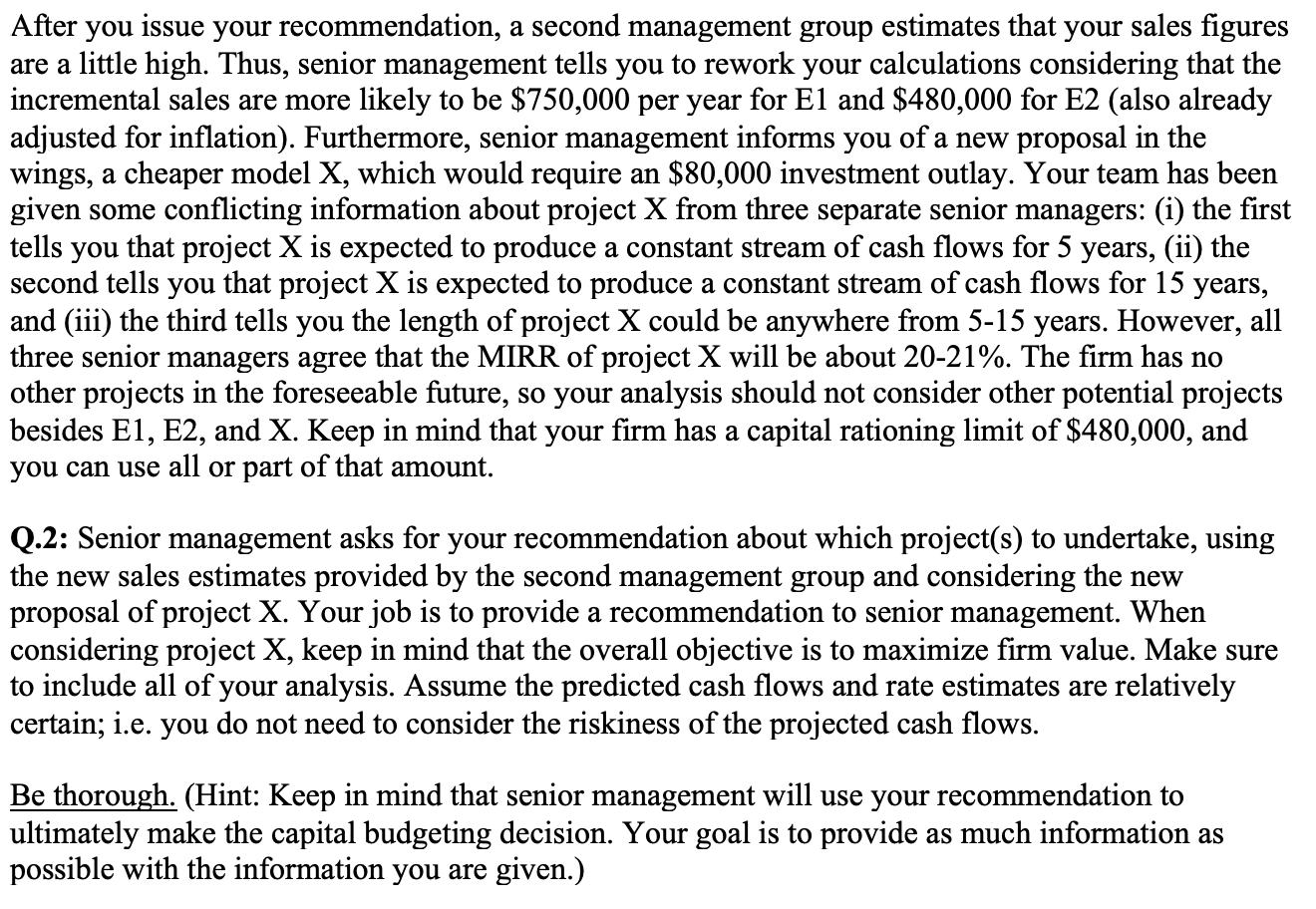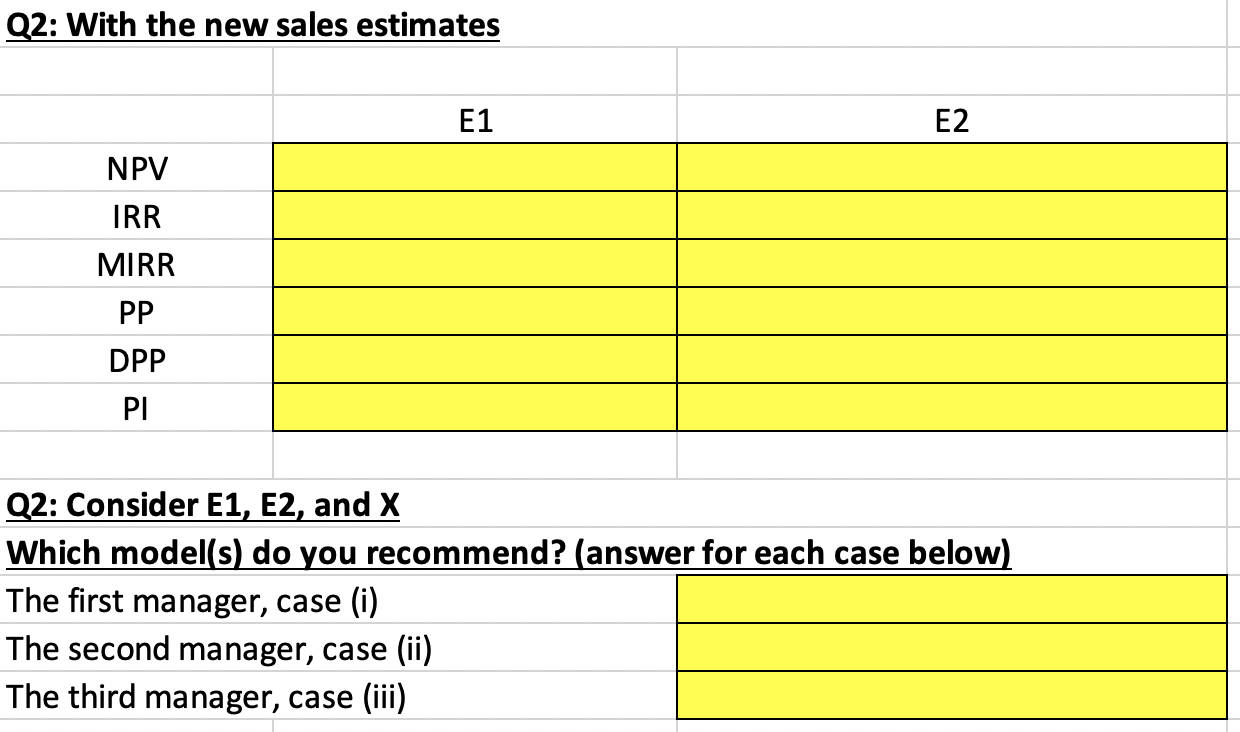Answered step by step
Verified Expert Solution
Question
1 Approved Answer
Please show the work, thank you! Case A major manufacturing company is considering the development of an entirely new electric vehicle. The engineers recommend two



Please show the work, thank you!
Case A major manufacturing company is considering the development of an entirely new electric vehicle. The engineers recommend two mutually exclusive models: The El model and the E2 model. The investment outlay for the El model has been computed to be $480,000, and the outlay for the E2 model has been computed to be $400,000. This initial outlay is depreciated on a straight line basis over a 20-yr period (no salvage value). The firm's cost of capital is 14%. The engineering group has estimated that the annual operating costs would be $480,000 for E1 and $250,000 for E2. Furthermore, it is estimated that the incremental annual sales would be $800,000 for El and $500,000 for E2. These figures are expected to remain constant over the next 20 years and are already adjusted for inflation. The corporate tax rate is 50%. Your management team must make a recommendation to senior management about which model should be adopted. After you issue your recommendation, a second management group estimates that your sales figures are a little high. Thus, senior management tells you to rework your calculations considering that the incremental sales are more likely to be $750,000 per year for El and $480,000 for E2 (also already adjusted for inflation). Furthermore, senior management informs you of a new proposal in the wings, a cheaper model X, which would require an $80,000 investment outlay. Your team has been given some conflicting information about project X from three separate senior managers: (i) the first tells you that project X is expected to produce a constant stream of cash flows for 5 years, (ii) the second tells you that project X is expected to produce a constant stream of cash flows for 15 years, and (iii) the third tells you the length of project X could be anywhere from 5-15 years. However, all three senior managers agree that the MIRR of project X will be about 20-21%. The firm has no other projects in the foreseeable future, so your analysis should not consider other potential projects besides E1, E2, and X. Keep in mind that your firm has a capital rationing limit of $480,000, and you can use all or part of that amount. Q.2: Senior management asks for your recommendation about which project(s) to undertake, using the new sales estimates provided by the second management group and considering the new proposal of project X. Your job is to provide a recommendation to senior management. When considering project X, keep in mind that the overall objective is to maximize firm value. Make sure to include all of your analysis. Assume the predicted cash flows and rate estimates are relatively certain; i.e. you do not need to consider the riskiness of the projected cash flows. Be thorough. (Hint: Keep in mind that senior management will use your recommendation to ultimately make the capital budgeting decision. Your goal is to provide as much information as possible with the information you are given.) Q2: With the new sales estimates E1 E2 NPV IRR MIRR PP DPP PL Q2: Consider E1, E2, and X Which model(s) do you recommend? (answer for each case below) The first manager, case (i) The second manager, case (ii) The third manager, case (iii) Case A major manufacturing company is considering the development of an entirely new electric vehicle. The engineers recommend two mutually exclusive models: The El model and the E2 model. The investment outlay for the El model has been computed to be $480,000, and the outlay for the E2 model has been computed to be $400,000. This initial outlay is depreciated on a straight line basis over a 20-yr period (no salvage value). The firm's cost of capital is 14%. The engineering group has estimated that the annual operating costs would be $480,000 for E1 and $250,000 for E2. Furthermore, it is estimated that the incremental annual sales would be $800,000 for El and $500,000 for E2. These figures are expected to remain constant over the next 20 years and are already adjusted for inflation. The corporate tax rate is 50%. Your management team must make a recommendation to senior management about which model should be adopted. After you issue your recommendation, a second management group estimates that your sales figures are a little high. Thus, senior management tells you to rework your calculations considering that the incremental sales are more likely to be $750,000 per year for El and $480,000 for E2 (also already adjusted for inflation). Furthermore, senior management informs you of a new proposal in the wings, a cheaper model X, which would require an $80,000 investment outlay. Your team has been given some conflicting information about project X from three separate senior managers: (i) the first tells you that project X is expected to produce a constant stream of cash flows for 5 years, (ii) the second tells you that project X is expected to produce a constant stream of cash flows for 15 years, and (iii) the third tells you the length of project X could be anywhere from 5-15 years. However, all three senior managers agree that the MIRR of project X will be about 20-21%. The firm has no other projects in the foreseeable future, so your analysis should not consider other potential projects besides E1, E2, and X. Keep in mind that your firm has a capital rationing limit of $480,000, and you can use all or part of that amount. Q.2: Senior management asks for your recommendation about which project(s) to undertake, using the new sales estimates provided by the second management group and considering the new proposal of project X. Your job is to provide a recommendation to senior management. When considering project X, keep in mind that the overall objective is to maximize firm value. Make sure to include all of your analysis. Assume the predicted cash flows and rate estimates are relatively certain; i.e. you do not need to consider the riskiness of the projected cash flows. Be thorough. (Hint: Keep in mind that senior management will use your recommendation to ultimately make the capital budgeting decision. Your goal is to provide as much information as possible with the information you are given.) Q2: With the new sales estimates E1 E2 NPV IRR MIRR PP DPP PL Q2: Consider E1, E2, and X Which model(s) do you recommend? (answer for each case below) The first manager, case (i) The second manager, case (ii) The third manager, case (iii)Step by Step Solution
There are 3 Steps involved in it
Step: 1

Get Instant Access to Expert-Tailored Solutions
See step-by-step solutions with expert insights and AI powered tools for academic success
Step: 2

Step: 3

Ace Your Homework with AI
Get the answers you need in no time with our AI-driven, step-by-step assistance
Get Started


